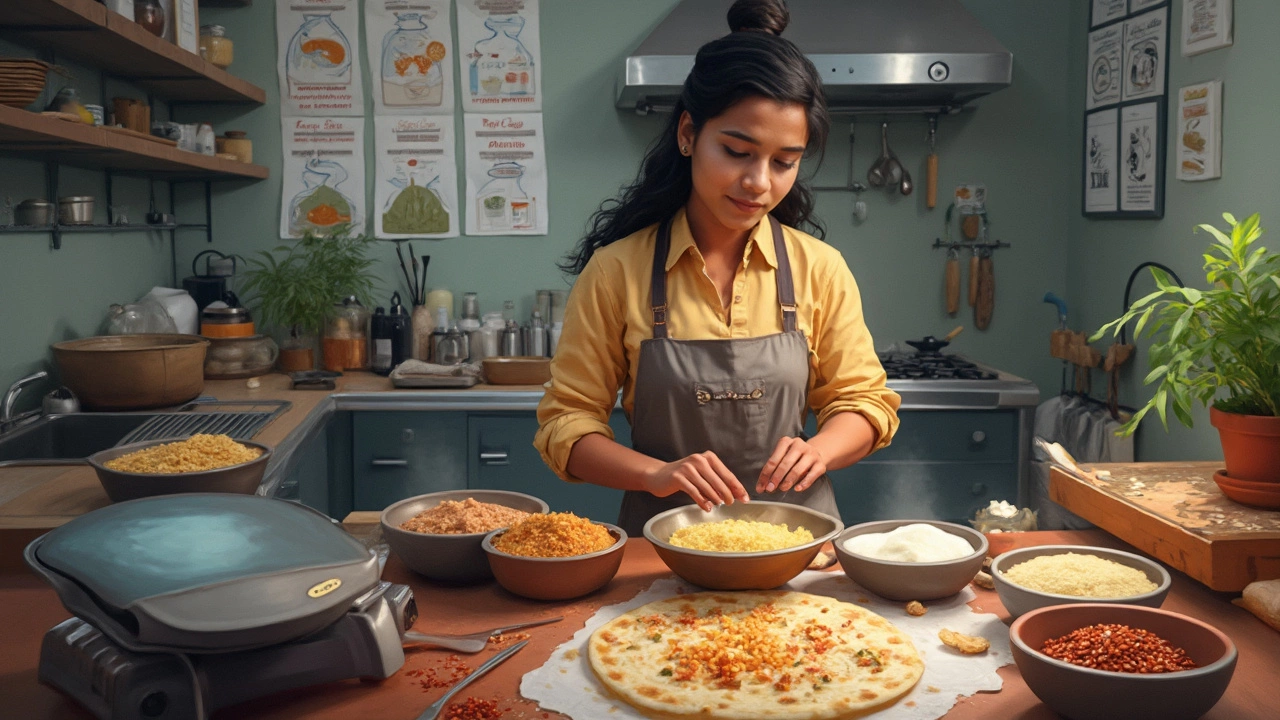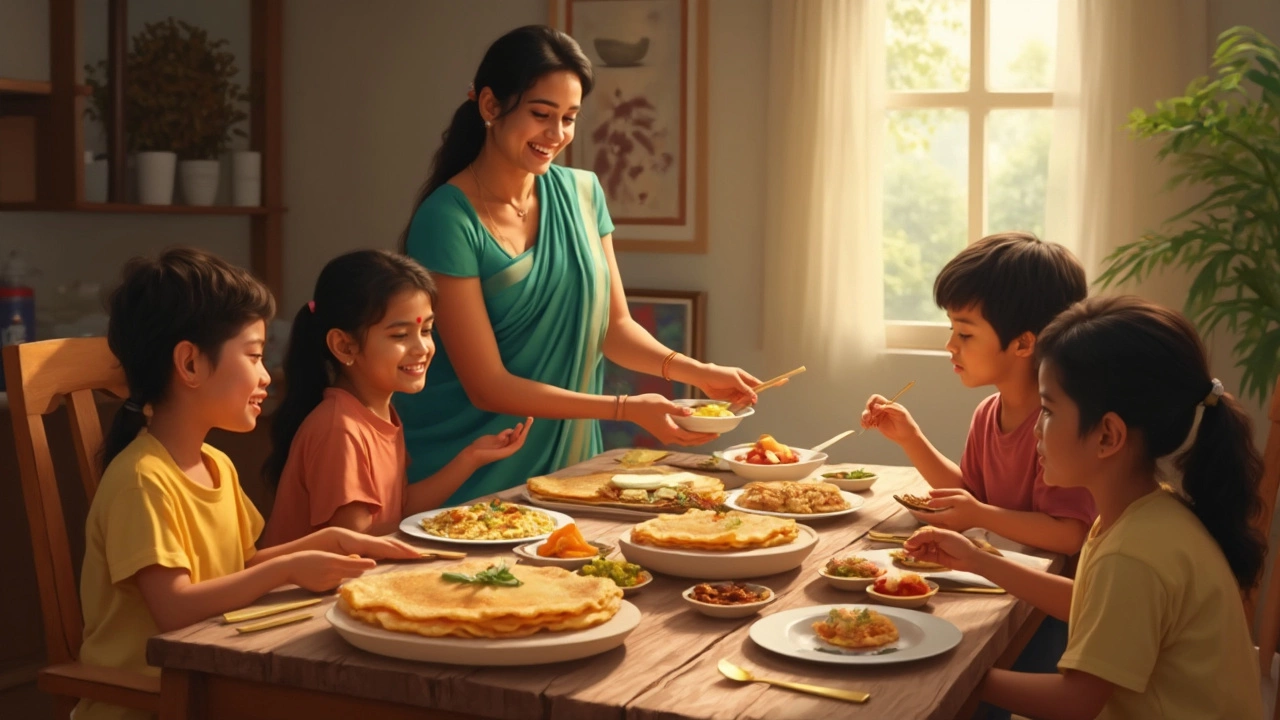Perfect Dosa Without Yeast: Quick Fermentation Tips
 Feb, 12 2025
Feb, 12 2025
Ever tried to make dosa and ended up with a flat, lifeless result? Don’t fret, it's all about the fermentation, and no, you don't need yeast to get it right! The magic starts with picking the right ingredients. Stick with a good quality rice—look for short-grain or idli rice—and mix it with urad dal.
Here's a cool tip: when grinding them, adding a bit of fenugreek seeds can help. They not only enhance flavor but also aid fermentation. Now, why does fermentation matter? It’s the science behind those perfect, bubbly batters and crispy dosas.
- Understanding Dosa Ingredients
- The Science Behind Fermentation
- Quick Fermentation Techniques
- Avoiding Common Mistakes
- Serving Suggestions
Understanding Dosa Ingredients
Dipping your toes into the world of dosa-making? It all begins with selecting the right ingredients. A dosa batter typically revolves around two main components: rice and urad dal. But there's more than meets the eye!
Choosing the Right Rice
Riscing it all starts with the rice. Opt for short-grain rice or specialized idli rice. These varieties are starchy and help give your dosa that delightful crispy texture. A high starch content is crucial for proper fermentation without yeast.
The Role of Urad Dal
Urad dal, or black gram, is a key player here. Its protein content not only adds nutritional value but also aids in the fermentation process. Some folks recommend using whole urad dal for better results.
Adding a Little Extra Magic
Ever wondered about the secret skip-the-yeast ingredient? It's none other than fenugreek seeds. With a spoonful mixed in, these seeds boost your batter’s fermentation, keeping it bubbly and light.
According to the renowned chef Sanjeev Kapoor, “Fenugreek seeds in dosa batter enhance flavor and support natural fermentation, making them indispensable.”
The Perfect Proportions
Getting the ratios right is a game-changer. Aim for a 3:1 or even a 4:1 ratio of rice to urad dal. These combinations maintain the balance between taste and texture.
| Ingredient | Amount |
|---|---|
| Rice | 3 cups |
| Urad Dal | 1 cup |
| Fenugreek Seeds | 1 teaspoon |
With these ingredients in place, you're setting the stage for the ultimate dosa experience. Remember, a good foundation is key to avoiding common mistakes that can flatten your culinary dreams!
The Science Behind Fermentation
So, what's the deal with fermentation and why is it key for making a killer dosa? Simply put, it's all about getting that batter to rise right. When you let the rice and urad dal mix sit, naturally occurring bacteria start munching on the starches and sugars.
These bacteria release carbon dioxide, leading to a natural leavening process. This is what gives the batter its airy texture — a must for that crispiness we all crave in a perfect dosa.
Natural Factors Influencing Fermentation
Temperature is a big player here. If you live in a warm climate, fermentation can happen quite fast, sometimes within just 8 to 10 hours. But if it’s on the cooler side, it might take longer. A little hack? Keep your batter in a pre-warmed oven or use an oven light to create a warm environment.
Another neat trick is to add a sprinkle of sugar. It gives those natural bacteria a bit of a kickstart, helping them do their job even faster.
Balancing Act of Ingredients
Ever feel the need to eyeball the rice-to-dal ratio? Here's a solid starting point: two parts rice to one part urad dal. This balance is ideal for fermentation and flavor.
And don’t skimp on the soak time. Four to six hours is usually good. This ensures everything is soft and ready for easy grinding and kicks off the fermentation process.
| Climate | Fermentation Time |
|---|---|
| Warm | 8-10 hours |
| Moderate | 12-15 hours |
| Cold | 16-18 hours |
So next time you're prepping for a dosa feast, keep these factors in mind. With the right techniques and a bit of patience, you'll nail that perfect dosa every time.

Quick Fermentation Techniques
Getting that perfect dosa batter ready without waiting ages can feel almost magical. Here's how you can speed things up!
Add the Right Ingredients
An often overlooked trick involves tossing in a handful of cooked rice while grinding your batter. This simple hack accelerates the fermentation process, ensuring your dosas are fluffy and soft. Also, remember to add a pinch of sugar. It acts as a catalyst.
Use Warmth Wisely
Another game-changer is creating the right environment. If you’re in a colder place, try placing the batter in a warm spot, like inside an off-oven with just the oven light on. Warmth is a key player in rapid fermentation.
Experiment with Innovative Methods
Some folks swear by adding a spoonful of leftover fermented batter from a previous batch to jumpstart the process. It’s like giving your batter a head start!
Monitor Your Water Quality
The type of water can impact your fermentation. If your water is high in chlorine, consider using filtered or bottled water instead. Too much chlorine can inhibit the process.
| Temperature | Fermentation Time Reduction |
|---|---|
| Cold (15°C) | 30% |
| Room Temp (25°C) | 50% |
| Warm (35°C) | 70% |
With these quick fermentation techniques, not only is your batter more reliable, but your dosa will also be the talk of the table. Whether you’re a newbie or a seasoned cook, these tricks are lifesavers!
Avoiding Common Mistakes
Making a dosa might seem straightforward, but slipping into common errors can ruin your crispy dreams. Let me walk you through some typical pitfalls and how to dodge them.
Sub-Par Rice and Dal
It might sound obvious, but choosing the right rice and dal is crucial. Don't skimp on quality here. Stick to high-quality short-grain or idli rice and good urad dal. Mixing ratios also matter—aim for about 3 parts rice to 1 part dal for that perfect ratio.
Fermentation Gone Wrong
Fermentation is where things can get tricky. If your batter isn’t fermenting well, double-check the temperature of your environment. If it's too cold, try keeping the batter in your oven with just the light on, or wrap it in a blanket.
Batter Consistency Issues
If your batter is too thin, your dosa will spread uncontrollably. Too thick, and it won't spread at all. Aim for a pancake-like consistency. Add water gradually until you get it right.
Greasy Or Sticky Dos
Over-greasing your pan can lead to soggy or sticky dosas. Use just a few drops of oil, and spread them with a half-sliced onion for even coating.
Cooking Without a Plan
Timing is everything. Once your pan is hot, pour and spread the batter quickly. Cook until golden brown and flip only if you like them extra crispy.
A little planning and attention to detail can make your dosa experience way more enjoyable.

Serving Suggestions
Now that you’ve nailed the perfect dosa without any yeast, let’s talk about how to serve these beauties. First off, you can never go wrong with the classic combo: dosa with coconut chutney and sambar. The creamy, slightly spicy chutney perfectly complements the crispy dosa.
Mix It Up with Different Chutneys
Don’t limit yourself to just coconut. Tomato chutney, mint-coriander chutney, or even peanut chutney are fantastic choices. They all bring their own unique flavors and will keep breakfast exciting.
Dosa Varieties and Fillings
If you're feeling adventurous, why not turn your basic dosa into a masala dosa? Just whip up a potato filling with onions, mustard seeds, and a hint of turmeric—simple yet delicious. You can also try adding grated cheese inside for a modern twist that the kids will absolutely adore.
- Plain dosa with a side of rasam is another excellent idea if you prefer something lighter.
- Stuffed dosa options are quite vast—think paneer, spicy chicken, or even mixed vegetables.
- Serving them with a drizzle of ghee or a spoon of butter on top doesn’t just taste amazing, it also makes your dosa look irresistible.
A Sweet Ending
Last but not least, if you're serving dosas for brunch or want to end on a sweet note, try pairing them with jaggery syrup or honey. It’s a surprisingly delightful combination that not too many people have tried.
Dosa isn’t just for breakfast; it can be a satisfying meal any time of the day. With these serving suggestions, you're all set to impress friends and family with your culinary skills!